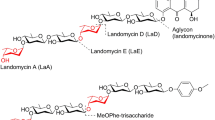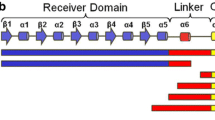Summary
The raf repressor negatively regulates the transcription of the raf operon which encodes functions required for the uptake and hydrolysis of raffinose in Escherichia coli. Overexpression of the repressor gene under lac promoter control led to the formation of inclusion bodies. These were partially purified by centrifugation, solubilized in 0.1 % SDS and reactivated by dilution. DNase I protection and gel retardation experiments demonstrated the specific binding of raf repressor to DNA fragments that contained the previously identified raf operator, an element comprising two 18 by palindromic nucleotide sequences that flank the −35 raf promoter box. By using DNA fragments with one, two, or four copies of the 18 by palindrome, these experiments revealed concentration dependent, successive occupation of all available binding sites by raf repressor. Melibiose released the repressor from the operator complexes, whereas raffinose and other α-galactosides did not, indicating that melibiose is the actual inducer in vivo. We suggest that successive occupation by repressor of two strategically located operator sites is a specific type of stepwise down-regulation of gene expression in response to repressor concentration.
Similar content being viewed by others
References
Aslanidis C, Schmitt R (1990) Regulatory elements of the raffinose operon: nucleotide sequence of operator and repressor genes. J Bacteriol 72:2178–2180
Aslanidis C, Schmid K, Schmitt R (1989) Nucleotide sequences and operon structure of plasmid-borne genes mediating uptake and utilization of raffinose in Escherichia coli. J Bacteriol 171:6753–6763
Brown JW, Thomm M, Beckler GS, Frey G, Stetter KO, Reeve JN (1988) An archaebacterial RNA polymerase binding site and transcription initiation of the hisA gene in Methanococcus vannielii. Nucleic Acids Res 16:135–150
Craig NL, Nash HA (1984) E. coli integration host factor binds to specific sites in DNA. Cell 39:707–716
Dunn TM, Hahn S, Ogden S, Schleif RF (1984) An operator at −280 base pairs that is required for repression of araBAD operon promoter: Addition of DNA helical turns between the operator and promoter cyclically hinders repression. Proc Natl Acad Sci USA 81:5017–5020
Eismann E, v. Wilcken-Bergmann B, Müller-Hill B (1987) Specific destruction of the second lac operator decreases repression of the lac operon in Escherichia coli fivefold. J Mol Biol 195:949–952
French D, Wild GM, Young B, James WJ (1953) Constitution of planteose. J Am Chem Soc 75:709–712
Fried M, Crothers DM (1981) Equilibria and kinetics of lac repressor-operator interactions by polyacrylamide gel electrophoresis. Nucleic Acids Res 9:6505–6525
Fritz H-J, Bicknäse H, Gleumes B, Heibach C, Rosahl S, Ehring R (1983) Characterization of two mutations in the Escherichia coli galE gene inactivating the second galactose operator and comparative studies of repressor binding. EMBO J 2:2129–2135
Garner MM, Revzin A (1981) A gel electrophoresis method for quantifying the binding of proteins to specific DNA regions: application to components of the E. coli lactose operon regulatory system. Nucleic Acids Res 9:3047–3060
Irani MH, Orosz L, Adhya S (1983) A control element within a structural gene: the gal operon of Escherichia coli. Cell 32:783–788
Jaenicke R (1987) Folding and association of proteins. Prog Biophys Mol Biol 49:117–237
Jaenicke R, Muiznieks I, Aslanidis C, Schmitt R (1990) Ultracentrifugal analysis of the quarternary structure of the raf repressor from Escherichia coli. FEBS Lett 260:233–235
Kane JF, Hartley DL (1988) Formation of recombinant protein inclusion bodies in Escherichia coli. Trends Biotechnol 6:95–101
Krämer H, Niemöller M, Amouyal M, Revet B, v. Wilcken-Bergmann B, Müller-Hill B (1987) lac repressor forms loops with linear DNA carrying two suitably spaced lac operators. EMBO J 6:1481–1491
Lanzer M, Bujard H (1988) Promoters largely determine the efficiency of repressor action. Proc Natl Acad Sci USA 8:8973–8977
Lehming N, Sartorius J, Niemöller M, Genenger G, v. Wilcken-Bergmann B, Müller-Hill B (1987) The interaction of the recognition helix of lac repressor with lac operator. EMBO J 6:3145–3153
Lehming N, Sartorius J, Kisters-Woike B, v. Wilcken-Bergmann B, Müller-Hill B (1990) Mutant lac repressors with new specificities hint at rules for protein DNA-recognition. EMBO J 9:615–621
Maniatis T, Fritsch EF, Sambrook J (1982) Molecular cloning: a laboratory manual. Cold Spring Harbor Laboratory Press, Cold Spring Harbor, New York
Maxam A, Gilbert W (1980) Sequencing end-labeled DNA with base-specific chemical cleavages. Methods Enzymol 65:499–560
Mitraki A, King J (1989) Protein folding intermediates and inclusion body formation. Biotechnology 7:690–697
Ohlendorf DH, Anderson WF, Fisher RG, Takeda Y, Matthews BW (1982) The molecular basis of protein-DNA recognition inferred from the structure of cro repressor. Nature 298:718–723
Pabo CO, Sauer RT (1984) Protein-DNA recognition. Annu Rev Biochem 53:293–321
Riggs AD, Bourgeois S, Cohn M (1970) The lac repressor-operator interaction III. Kinetic studies. J Mol Biol 53:401–417
Sartorius J, Lehming N, Kisters B, v. Wilcken-Bergmann B, Müller-Hill B (1989) lac repressor mutants with double or triple exchanges in the recognition helix bind specifically to lac operator variants with multiple exchanges. EMBO J 8:1265–1270
Schmid K, Schmitt R (1976) Raffinose metabolism in Escherichia coli K12. Purification and properties of a new α-galactosidase specified by a transmissible plasmid. Eur J Biochem 67:95–104
Sherman F, Stewart JW, Tsunasawa S (1984) Methionine or not methionine at the beginning of a protein. Bioessays 3:27–31
Tuggle CK, Fuchs JA (1986) Regulation of the operon encoding ribonucleotide reductase in Escherichia coli: evidence for both positive and negative control. EMBO J 5:1077–1085
Valentin-Hansen P, Albrechtsen B, Love Larsen JE (1986) DNA-protein recognition: demonstration of three genetically separated operator-elements that are required for repression of the Escherichia coli deoCABD promoters by the DeoR repressor. EMBO J 5:2015–2021
Vieira J, Messing J (1982) The pUC plasmids, an M13mp7-derived system for insertion mutagenesis and sequencing with synthetic universal primers. Gene 33:259–268
Yanisch-Perron C, Vieira J, Messing J (1985) Improved M13 phage cloning vectors and host strains: nucleotide sequences of the Ml3mp8 and pUC19 vectors. Gene 33:103–119
Author information
Authors and Affiliations
Additional information
Communicated by J.W. Lengeler
Rights and permissions
About this article
Cite this article
Aslanidis, C., Muiznieks, I. & Schmitt, R. Successive binding of raf repressor to adjacent raf operator sites in vitro. Molec. Gen. Genet. 223, 297–304 (1990). https://doi.org/10.1007/BF00265066
Received:
Issue Date:
DOI: https://doi.org/10.1007/BF00265066




